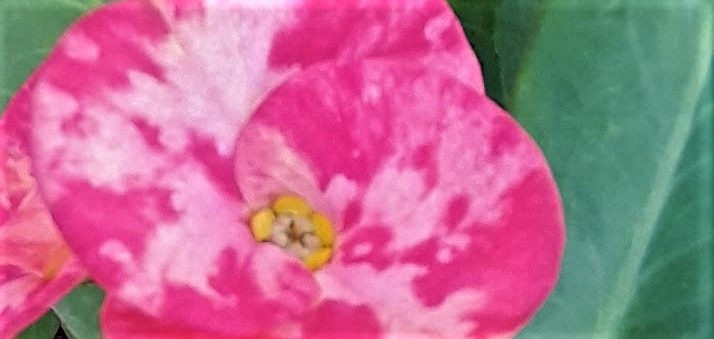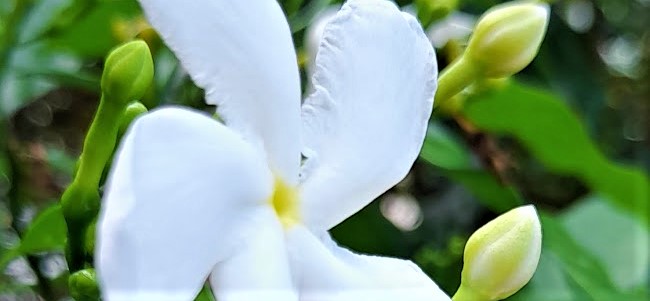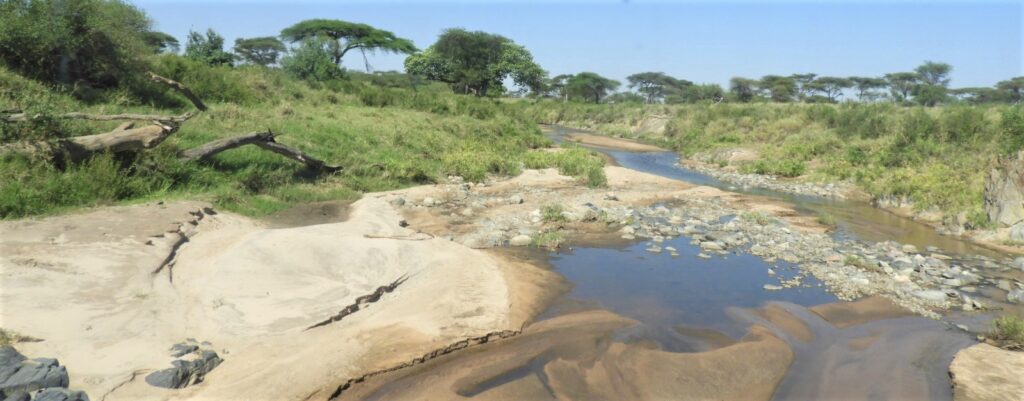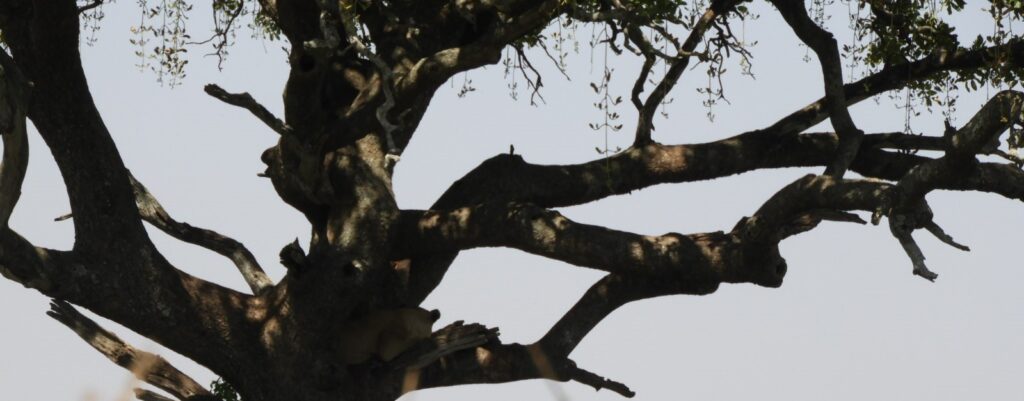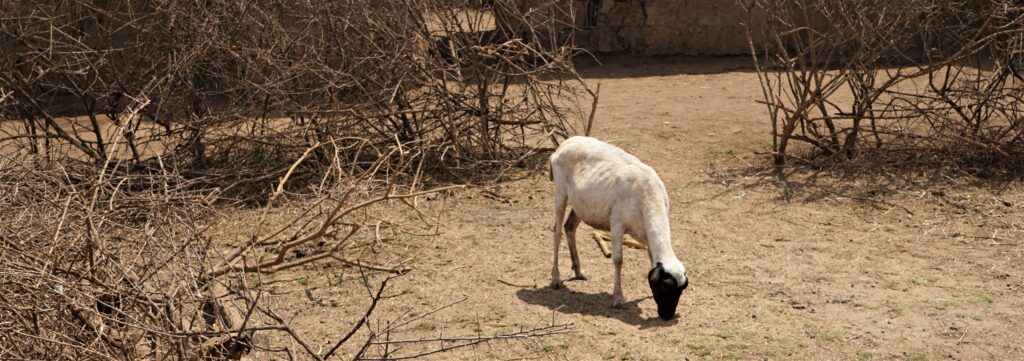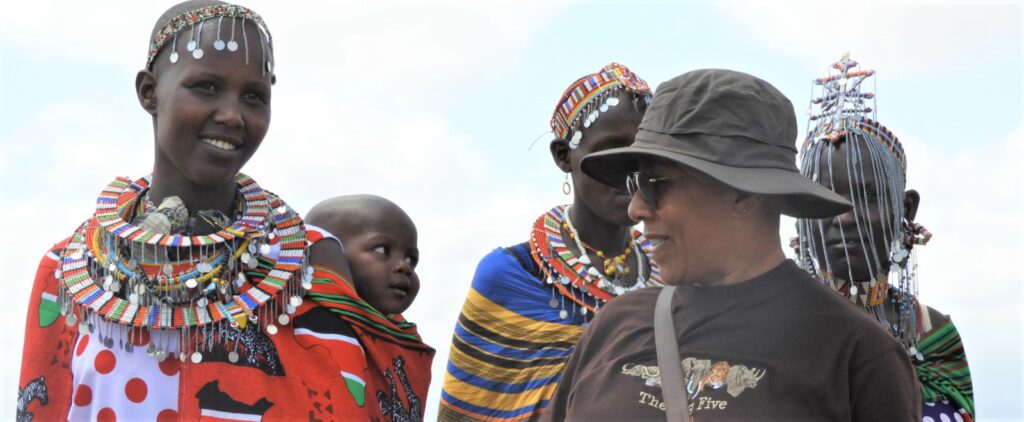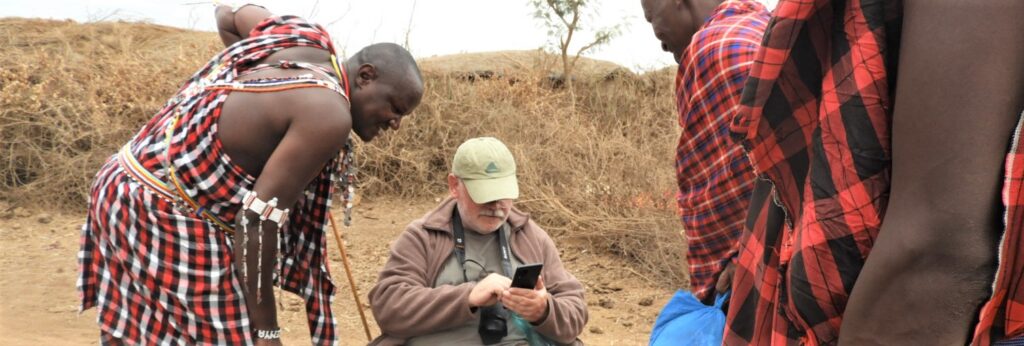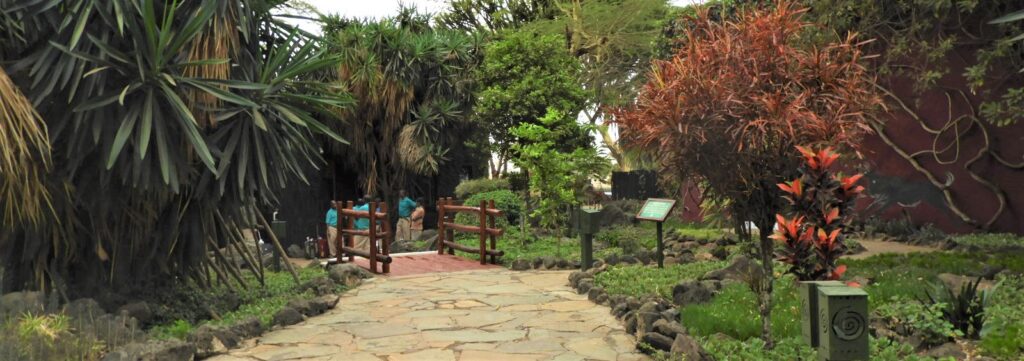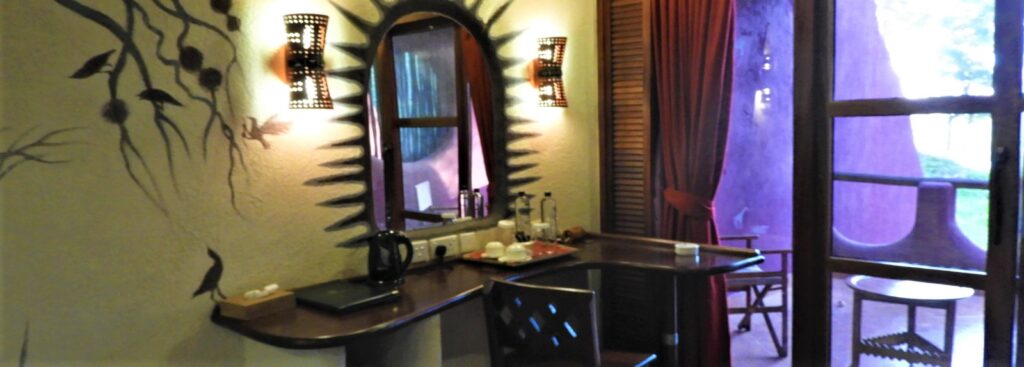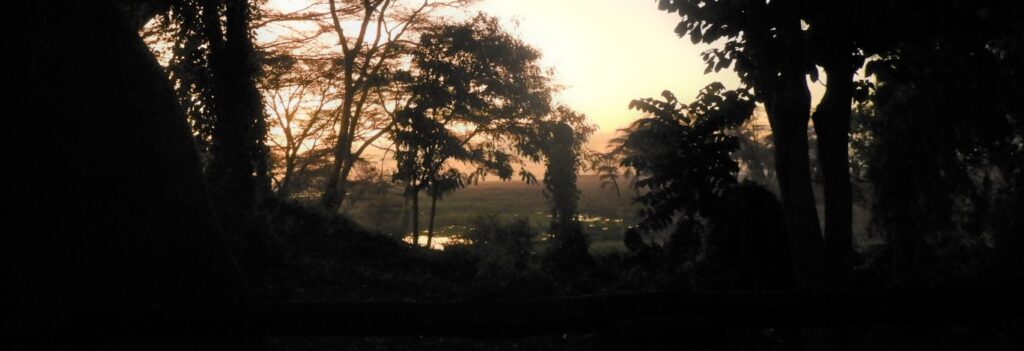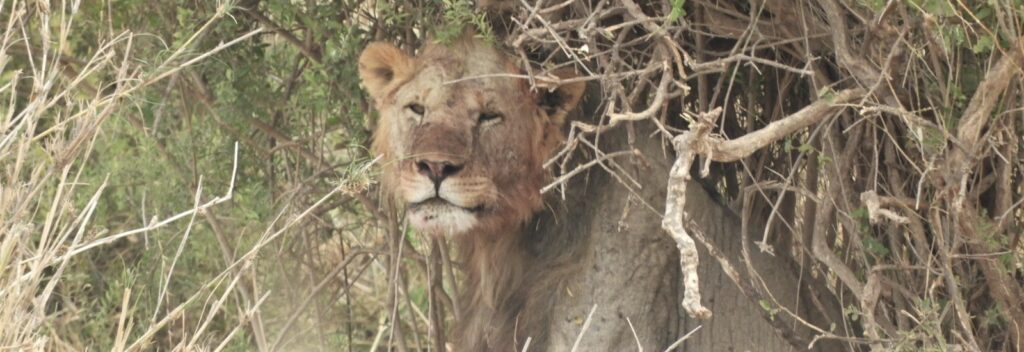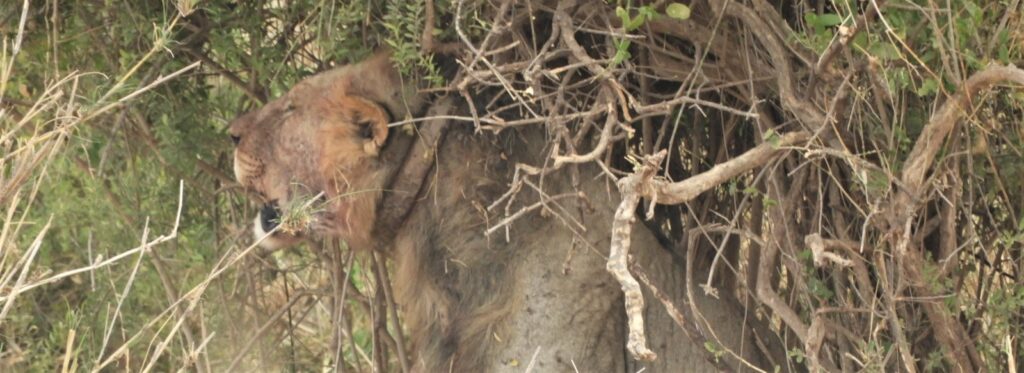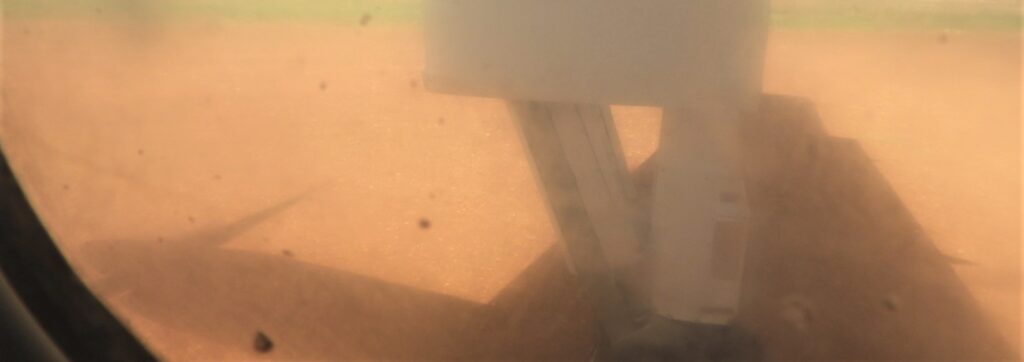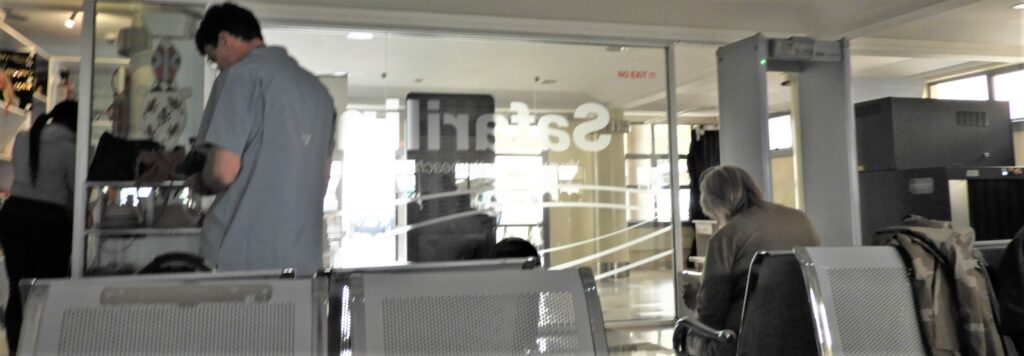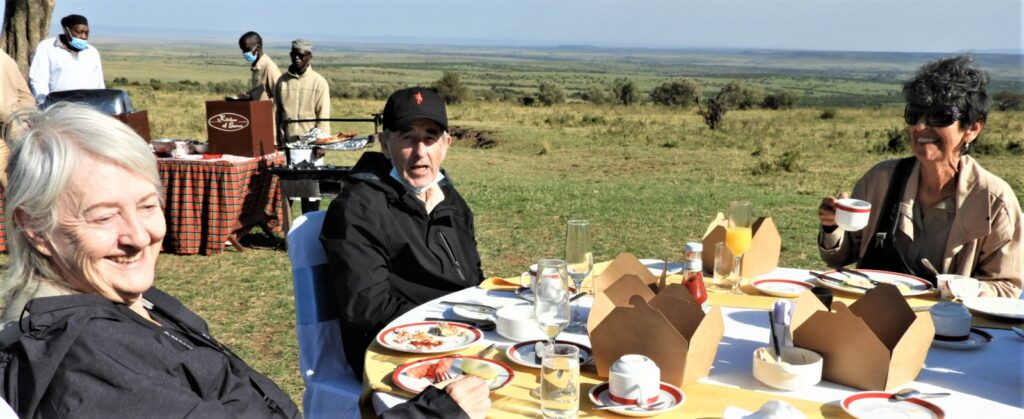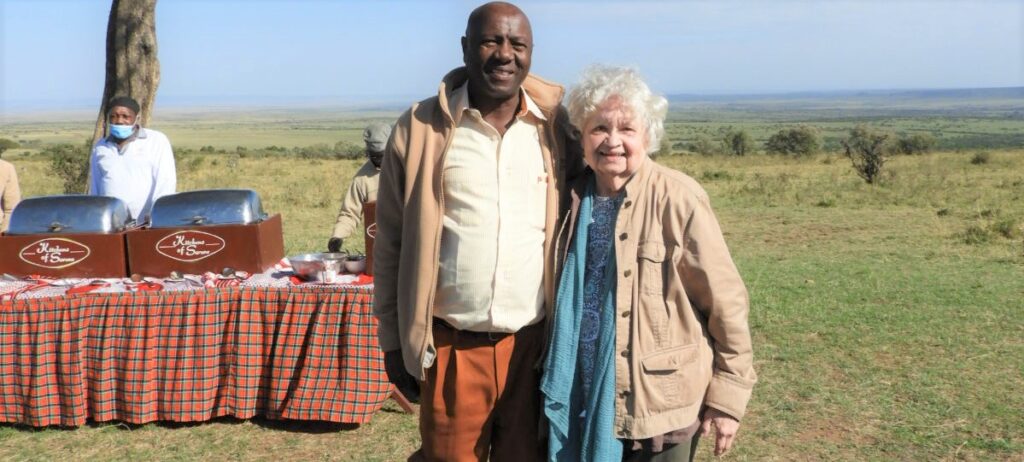Posts Tagged ‘Kenya’
» posted on Tuesday, September 27th, 2022 by Linda Lou Burton
Till Time To Go
 Linda Lou Burton posting from Zanzibar Serena Hotel, Stone Town, Zanzibar, Tanzania –
Linda Lou Burton posting from Zanzibar Serena Hotel, Stone Town, Zanzibar, Tanzania – 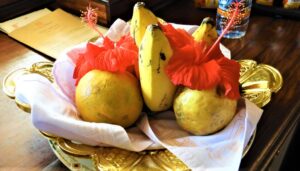 They left a bowl of fruit and flowers in our room when they cleaned every day. I’m sitting on our porch now, eating a banana, thinking about, well, food. People were curious about what we’d eat in Africa. I had studied in advance – what grows there, how it’s prepared, absolute favorites. I vowed to try “at least a bite” of as many different things as I could, although our brains and stomachs tend to crave the familiar. Beans, corn, greens, tomatoes – familiars to me that I knew I’d find in Africa. I knew there would be more dishes featuring bananas and coconut than I have in my routine; I was looking forward to that. So how did it turn out? Here are 10 Things I read about ahead of time:
They left a bowl of fruit and flowers in our room when they cleaned every day. I’m sitting on our porch now, eating a banana, thinking about, well, food. People were curious about what we’d eat in Africa. I had studied in advance – what grows there, how it’s prepared, absolute favorites. I vowed to try “at least a bite” of as many different things as I could, although our brains and stomachs tend to crave the familiar. Beans, corn, greens, tomatoes – familiars to me that I knew I’d find in Africa. I knew there would be more dishes featuring bananas and coconut than I have in my routine; I was looking forward to that. So how did it turn out? Here are 10 Things I read about ahead of time:
- Ugali – maize is a major crop in Kenya and Tanzania. Ugali is standard fare; everybody eats it! Take cornmeal, boil it into a paste; roll it into a ball; eat it with your soups or stews or anything. Like the cornbread I grew up on, only boiled not baked. Did I eat ugali? I honestly don’t know! I tried lots of breads but don’t remember seeing “balled paste” on the Serena buffets. I think I’ll try making it at home, just to be sure.
- Githeri – a favorite in the Kikuyu community; corn and beans, first boiled, then fried. Avocado is often added; all served on rice. Sounds a bit like Mexican food I’ve eaten, agree?
- Ingoho – like the Thanksgiving turkey, Ingoho – chicken – is prepared in Kenya as a special meal; roast the chicken until it is brown; then braise it with onions, tomatoes and spices.
- Kachumbari – claims to be Kenya’s “most delicious salad.” Thin slices of fresh ripe tomatoes, onions, green/red peppers, lemon juice, coriander. I don’t remember seeing the name tag on our buffet’s selections, but every meal had interesting (and beautiful) salads. All delicious.
- Mandazi – oh yes! A very popular sweet! The dough is made with sugar, flour, water, yeast, coconut milk (ground peanuts or almonds can be added). Fry in hot oil, dust with powdered sugar or cinnamon, eat for breakfast or anytime! I remember this one.
- Mchemsho – this means “something boiled” and could be any number of vegetables such as potatoes, green beans, carrots, tomatoes, cabbage, eggplant. Definitely ate this!
- Mukimo –I’ll be making this at home. Mash some potatoes, then add spinach, corn, peas, whatever, for added flavor. I’ve made colcannon (around St Paddy’s day); love it!
- Ndizi na nyama – a favorite in Tanzania this is bananas (ndizi) and meat (nyama) made into a stew with curry powder, cayenne pepper, oil, onions, tomatoes, and coconut milk. Simmer then serve with rice, or ugali! I don’t remember seeing this but I think I’ll try it at home.
- Nyama Choma – Swahili for “grilled meat;” both countries are fond of goat, beef, chicken or fish grilled over charcoal. Our bush meals usually had a grill going for an outdoor feast.
- Rice – rice was everywhere, cooked every which way. In Tanzania, Wali wa nazi is rice cooked in coconut milk and water, seasoned only with salt. In Kenya Pilau is a special rice cooked with spices and chicken or beef.
 Why am I thinking about FOOD as I sit on our porch in Zanzibar, till time to get on a plane headed far, far north? A change awaits us in Iceland, for sure! I’m ticking off their favorites in my head: skyr (kind of like yogurt); ice cream and cheese (yes, they are mad about ice cream!); rye bread and butter (I can dig that); lamb (lamb stew, lamb roasted, lamb sirloin?) and, of course, FISH. Icelanders eat fish every single day. Pretty popular in Zanzibar too, I’m thinking, as another fishing boat goes by. Ali is picking us up at 7, better zip up the old fancy-schmancy suitcase, one more time. Look at these flowers we’ve been enjoying here by the Indian Ocean, while I go back inside a minute. We won’t see them in Iceland!
Why am I thinking about FOOD as I sit on our porch in Zanzibar, till time to get on a plane headed far, far north? A change awaits us in Iceland, for sure! I’m ticking off their favorites in my head: skyr (kind of like yogurt); ice cream and cheese (yes, they are mad about ice cream!); rye bread and butter (I can dig that); lamb (lamb stew, lamb roasted, lamb sirloin?) and, of course, FISH. Icelanders eat fish every single day. Pretty popular in Zanzibar too, I’m thinking, as another fishing boat goes by. Ali is picking us up at 7, better zip up the old fancy-schmancy suitcase, one more time. Look at these flowers we’ve been enjoying here by the Indian Ocean, while I go back inside a minute. We won’t see them in Iceland!
Credit Rick with the flower closeups.
Zanzibar Serena Hotel https://www.serenahotels.com/zanzibar
Fisherman’s Tours https://fishermantours.com/
Next Post: Hot Water
» posted on Saturday, September 24th, 2022 by Linda Lou Burton
Even Safaris End
 Linda Lou Burton posting from Seronera Airstrip, Serengeti National Park, Tanzania–Some things you never want to forget. I’ll remember my gripes about this fast-paced-energy-charged safari for a long time. It’s been exhausting! But I’ll remember the giraffes forever. That very first day, when I gently placed a pellet on the gray velvet tongue of a giraffe and looked straight into those eyes with their Hollywood lashes, I was forever taken in. They look amazing in the wild too; in every photo I took, zooming across the grasslands, those beautiful long lashes stand out. I’ll remember the neat-looking zebras, and their unlikely best buds, the scraggly wildebeests, what an odd, but wildly successful, relationship! I’ll remember the pudgy hippos with their sublime mudpuddle grins and the rhinos with those not very attractive outgrowths stuck to the top of their faces that make them a desirable target for mean money makers. I’ll remember the elephants, going at life full-force, pushing over trees and slinging dust every which way, but so tender hearted they grieve when they lose a loved one. I’ll remember the many species of antelope, with their dainty, pretty, sometimes
Linda Lou Burton posting from Seronera Airstrip, Serengeti National Park, Tanzania–Some things you never want to forget. I’ll remember my gripes about this fast-paced-energy-charged safari for a long time. It’s been exhausting! But I’ll remember the giraffes forever. That very first day, when I gently placed a pellet on the gray velvet tongue of a giraffe and looked straight into those eyes with their Hollywood lashes, I was forever taken in. They look amazing in the wild too; in every photo I took, zooming across the grasslands, those beautiful long lashes stand out. I’ll remember the neat-looking zebras, and their unlikely best buds, the scraggly wildebeests, what an odd, but wildly successful, relationship! I’ll remember the pudgy hippos with their sublime mudpuddle grins and the rhinos with those not very attractive outgrowths stuck to the top of their faces that make them a desirable target for mean money makers. I’ll remember the elephants, going at life full-force, pushing over trees and slinging dust every which way, but so tender hearted they grieve when they lose a loved one. I’ll remember the many species of antelope, with their dainty, pretty, sometimes 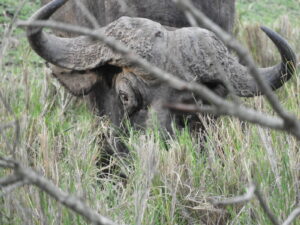 fairytale swirls of horns, and the big broad sweep of the buffalo’s “boss” stretching across the top of his head. I’ll remember the land plover, fearlessly guarding her two tiny eggs laying among the rocks at the side of the road. As for the lions, well sure, I know they have teeth and jaw powerful enough to bite off my arm, but what I’ll remember is all that sleeping, and stretching, and sleeping, just like my sweet little Katy cat. Overall in my memories, however, is the land, the landscape, the home for these animals. The acacia trees dotted across the open plains are planted firmly in my dreams. What a fitting place to end our safari today – the Serengeti. Even the name is beautiful – “serengeti” is an approximation of the word “siringet” used by the Maasai meaning “the place where the land runs on forever.”
fairytale swirls of horns, and the big broad sweep of the buffalo’s “boss” stretching across the top of his head. I’ll remember the land plover, fearlessly guarding her two tiny eggs laying among the rocks at the side of the road. As for the lions, well sure, I know they have teeth and jaw powerful enough to bite off my arm, but what I’ll remember is all that sleeping, and stretching, and sleeping, just like my sweet little Katy cat. Overall in my memories, however, is the land, the landscape, the home for these animals. The acacia trees dotted across the open plains are planted firmly in my dreams. What a fitting place to end our safari today – the Serengeti. Even the name is beautiful – “serengeti” is an approximation of the word “siringet” used by the Maasai meaning “the place where the land runs on forever.”
Early morning packing (don’t forget that hustle!) to taking pictures of each other, just before boarding our plane. The first animals of the day were two cape buffalo by our front porch (yes, I called security). The last animal (surprise!) was the long awaited “tree-climbing lion.” I reminded Willy of our fruitless search at Lake Manyara, saying “Willy, don’t let us leave forever without seeing a lion in a tree.” By golly, he found one. Do you see a lion in that nice shady tree? Willy did! He moved the 4×4 so we could see both back and front.
Serengeti National Park is a World Heritage Site covering 5,700 square miles of grassland plains, savanna, riverine forest, and woodlands. It lies in northwestern Tanzania, bordered to the north by Kenya, where it adjoins the Maasai Mara National Reserve. To the southeast is the Ngorongoro Conservation Area, to the southwest the Ikorongo and Grumeti Game Reserves, and to the northeast and east the Loliondo Game Control Area. This space teems with wildlife – over 2 million ungulates, 4,000 lions, 1,000 leopards, 550 cheetahs, and some 500 bird species. The Serengeti is well known for the largest annual animal migration in the world of over 1.5 million blue wildebeest and 250,000 zebra along with smaller herds of Thomas’ Gazelle and eland. The Park is also home to the largest lion population in Africa.
The park is divided into three regions:
- Serengeti plains: The best-known feature of the Serengeti is the almost treeless grassland in the south. It has kopjes, granite formations that serve as observation posts for predators.
- Western corridor: The Grumeti and Mbalageti. Rivers, big groups of riverine forest, and small mountain ranges stretch to Lake Victoria. The great migration passes through the corridor from May to July.
- Northern Serengeti: This remote and relatively inaccessible area is dominated by open woodlands and hills, ranging from Seronera in the south to the Mara River on the Kenyan border.
Human habitation is forbidden in the Park except for the Tanzania National Parks Authority staff, researchers and staff of the various lodges, campsites, and hotels. The main settlement is Seronera with its primary airstrip.
Serengeti National Park https://www.serengeti.com/
Next Post: A Story Of Water
» posted on Monday, September 19th, 2022 by Linda Lou Burton
Going to Namanga
Linda Lou Burton posting from Namanga, Kenya– ”You’ll have a nice big bus from the 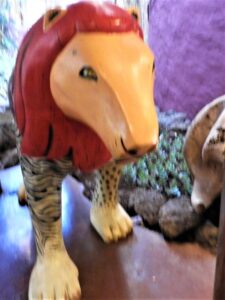 border to Arusha,” Abdi informed us at breakfast. “You all get to ride together.” We cheered, and headed out, past the Simba lion that guarded the door of the dining room, across the timbered bridge and past the sign that warned of monkey bites; ready to ride. The Lodge at Lake Manyara was our destination today, Tanzania! To a person we were glad to be leaving Amboseli’s dust for the promise of the beautiful blue waters of a lake. That, however was almost 200 miles away, 5 hours as the crow flies, but we were not flying. We had many hurtles ahead; many stops; many waits. Many changes of vehicle, and personnel. From our Amboseli Lodge our two Globus drivers, Amos, and the one I’d never even met, would take us to Namanga, the last leg of our journey in Kenya.
border to Arusha,” Abdi informed us at breakfast. “You all get to ride together.” We cheered, and headed out, past the Simba lion that guarded the door of the dining room, across the timbered bridge and past the sign that warned of monkey bites; ready to ride. The Lodge at Lake Manyara was our destination today, Tanzania! To a person we were glad to be leaving Amboseli’s dust for the promise of the beautiful blue waters of a lake. That, however was almost 200 miles away, 5 hours as the crow flies, but we were not flying. We had many hurtles ahead; many stops; many waits. Many changes of vehicle, and personnel. From our Amboseli Lodge our two Globus drivers, Amos, and the one I’d never even met, would take us to Namanga, the last leg of our journey in Kenya.
Namanga is a border town, split between Kenya and Tanzania; about 100 miles south of Nairobi and 70 miles north of Arusha; its population is somewhere upwards of 10,000. Tourism supports the town – anyone from Nairobi going to Mt Kilimanjaro passes through the Namanga border crossing. Hills and mountains surround the town – Mt Kili is visible from there; so is Ol Doinyo Orok mountain, also called the Black Mountain, sacred to the Maasai; stretching to the north are the Maparasha Hills. The economy of Namanga also includes the import-export business; trucks haul goods back and forth non-stop between the two countries. Namanga’s main population is Maasai, Kikuyu second; other ethnicity groups include Kama, Somali, Borana, a mixed population.
So how did it go? What did we see between our 7:15 departure and 9:30 when we walked into the Namanga One Stop Border Post? Our route was C103 west after departing Amboseli NP, unpaved and dusty red for 50 miles. Take a look.
Next Post: It Wasn’t Exactly A Bus
» posted on Sunday, September 18th, 2022 by Linda Lou Burton
The Dimming Of The Day
Linda Lou Burton posting from Amboseli Serena Safari Lodge, Amboseli National Park, 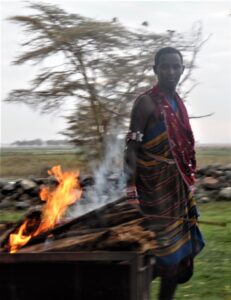 Kenya– It was our last night in Kenya, our last night with Abdi. Tomorrow we crossed the border into Tanzania; tomorrow we got new drivers; a new guide. The gang of us was seated semi-circle, our chairs in perfect position on the lawn of the Lodge to watch the sun set on mighty Kilimanjaro in a blaze of orange and red, relaxing at the end of our safari day with G&T in hand. Sundowners: a British tradition. Tonight however, the sunset was missing.
Kenya– It was our last night in Kenya, our last night with Abdi. Tomorrow we crossed the border into Tanzania; tomorrow we got new drivers; a new guide. The gang of us was seated semi-circle, our chairs in perfect position on the lawn of the Lodge to watch the sun set on mighty Kilimanjaro in a blaze of orange and red, relaxing at the end of our safari day with G&T in hand. Sundowners: a British tradition. Tonight however, the sunset was missing.
The mountain was socked in, invisible. The colors tonight, beyond the blaze of the campfire, beyond the green of the swamp and the brown dust of the fields beyond that, was gray; a gloomy look. Abdi spoke of new friendships, new insights gained; urging us to tell others, back home, about Kenya. Amos spoke, reminding us of realities we’d witnessed for ourselves in Amboseli; the images of the day flashed through my mind, the contrasts. 
So much to think about, so much to remember. The gang of us on safari, plus our guide Abdi standing, driver Amos 3rd from right. 
A Brief History of Amboseli National Park
Amboseli National Park is 97,117 acres in size at the core of a 1,976,843-acre ecosystem that spreads across the Kenya-Tanzania border. The park protects two of five main swamps, and includes a dried-up Pleistocene lake and semiarid vegetation. The local people are mainly Maasai.
It was 1883 when European Jeremy Thompson first penetrated the Maasai region known as Empusel (meaning ‘salty, dusty place’ in Maa); he was astonished by the fantastic array of wildlife and the contrast between the arid areas of the dry lake bed and the oasis of the swamps, a contrast that persists today. Amboseli was set aside as the Southern Reserve for the Maasai in 1906, but returned to local control as a game reserve in 1948. Gazetted a national park in 1974 to protect the core of this unique ecosystem, it was declared a UNESCO site in 1991. In 2005, Kenyan President Mwai Kibaki declared that control of the park should pass from the Kenya Wildlife Service to the Olkejuado County Council and the Maasai tribe; legal challenges are currently in court. The degazetting would divert park admission fees directly to the county council with shared benefits to the Maasai immediately surrounding the park.
» posted on Sunday, September 18th, 2022 by Linda Lou Burton
Olasiti Village
Linda Lou Burton posting from Olasiti Village, Amboseli National Park, Kenya– I met a Maasai chief today. His name is Benson Meoli. Our visit to his village was one of the perks, or  experiences, offered through Serena Amboseli Lodge, for a fee; an opportunity to learn more about Maasai culture. The Village was barely a 15-minute drive across the dusty landscape (once we exited the swampy lushness of the Lodge); Abdi had directed, ahead of time, that a chair awaited me. It was hot, and dusty there, one lone tree offering a bit of shade; after introductions Benson quickly dispatched others to bring more chairs, till everyone was comfortably seated in the meager shade. “You can ask him anything,” Abdi said, as Benson stood, a splendid man, patient and composed, awaiting his turn to speak.
experiences, offered through Serena Amboseli Lodge, for a fee; an opportunity to learn more about Maasai culture. The Village was barely a 15-minute drive across the dusty landscape (once we exited the swampy lushness of the Lodge); Abdi had directed, ahead of time, that a chair awaited me. It was hot, and dusty there, one lone tree offering a bit of shade; after introductions Benson quickly dispatched others to bring more chairs, till everyone was comfortably seated in the meager shade. “You can ask him anything,” Abdi said, as Benson stood, a splendid man, patient and composed, awaiting his turn to speak.
Before our visit ended, he had talked about the Maasai spirit; the belief in community. He gave examples of responsibility, bravery, health. There were demonstrations (how to build a fire, together, each person playing a significant part). There were others who spoke (the village doctor; the purity of their diet; no arthritis, lean physiques). We were shown how the round straw-roofed houses are built (sticks for the frame, plastered with cow dung, no windows); we were invited to go inside.
And we were invited to join the dance. Of course they danced for us; the men the famous Maasai jumping dance, as tourists expect; the women paraded in their colorful garb, singing strong. Lois joined them, I stepped forward too, with cane of course; someone quickly took my hand. Mike and Otis joined the jumping dance; Venita and Judy admired the baby, Benson’s son, we were told, a beautiful boy. Rick was given an honorary Maasai name; Ed and Maureen got photos, all around.
And then, the sell. The women spread their wares across the dust; blankets covered in beads, elaborate decorations for the neck, the arms; bookmarks designed as birds, giraffes; magnets for the fridge. A visit to the school; the children came today, a holiday, especially to sing for us. The pressure push was strong, but underneath, the message clear.
 Olasiti Village is in trouble. Their cattle are dying, like the zebras we saw the day before. Their cattle, their livelihood, are dying of thirst. There is no life without water, and the water is disappearing, fast. For four years now, the rains have failed to come. The village well, their one and only water source, connects to the aquifer that connects to the mountain that looms above, and the glaciers on that mountain are disappearing, fast. Behind all the niceties, and smiles, and beaded charms, these people need help.
Olasiti Village is in trouble. Their cattle are dying, like the zebras we saw the day before. Their cattle, their livelihood, are dying of thirst. There is no life without water, and the water is disappearing, fast. For four years now, the rains have failed to come. The village well, their one and only water source, connects to the aquifer that connects to the mountain that looms above, and the glaciers on that mountain are disappearing, fast. Behind all the niceties, and smiles, and beaded charms, these people need help.
Benson Meoli, the Maasai chief I met today, asks that we do what we can.
Olasiti Village, Kenya https://www.olasitimaasai.com/
» posted on Saturday, September 17th, 2022 by Linda Lou Burton
Painted Birds
Linda Lou Burton posting from Amboseli Serena Safari Lodge, Amboseli National Park, Kenya– It was 6 PM when we arrived, walking zombie-like into our stopping place for the next two nights. Fourteen hours gone since we set our luggage out for pickup at Sarova. Years had passed, it seemed, since our breakfast on that Maasai Mara hill; since we laughed our way through two airport stops, two crowded flights from there to here, this different dusty world with contradictions everywhere.
There were familiars; our gang, assembled once again in a greeting room; Abdi busy at the desk checking us in. The welcome by the staff; new keys; new rooms. Brilliant colors, the Maasai red; lush palms and bright green ferns; vines for real and painted vines; and birds, flying, fluttering; painted on the walls.
Dinner at 7:30 in the dining room, Abdi had advised. Safari cookies at the airport was all I’d had since breakfast, but I could not go. Bone weary, but more than that. I didn’t want to hear another word of gloom. “You go ahead,” I said to Rick; as we dumped belongings in our new room; tiny; twin beds in the corner, mosquito-netted; the corner desk, two bottles of glassed-in water; glass doors to the porch. We’d been instructed about those doors. They must be kept closed or the monkeys will come in and steal our stuff. And never leave anything outside.
Rick washed up, readying for dinner. “Can I bring you anything?” he asked, when he got to the door. “Some soup, and a roll,” I replied. “Doesn’t matter what kind.” Our porch looked out over a swampy spot. I sat there in the quiet till it was dark. Doors closed. 
Amboseli Serena Safari Lodge https://www.serenahotels.com/amboseli
From their website.
Surrounded by the vast and beautiful landscape of Amboseli National Park, Amboseli Serena Safari Lodge provides a full immersion into life in the untamed bush. Each room is housed in a single-story building opening directly onto the grounds, and each reflects a Maasai Manyatta theme with hand-painted wildlife murals, locally inspired furnishings, and the brilliant primary colors symbolic of these fabled warriors. 92 rooms and one suite feature complimentary wireless Internet, 24-hour room service and private balconies.
Our central dining area is reached by a timbered bridge spanning a mountain-fed stream and is flanked by water gardens. The walls feature hand-painted wildlife murals and the décor reflects the culture and heritage of the Maasai people. The spacious lounge and bar feature a broad terrace and a blazing fire-pit where evening cocktails can be enjoyed.
» posted on Saturday, September 17th, 2022 by Linda Lou Burton
The Kill
Linda Lou Burton posting from Amboseli National Park, Kenya–“That’s another one dying  of thirst,” Amos said. “They get so weak they can barely move.” Amos was our new driver; we’d assembled in our vehicle the same way as we did before – Rick and me third row back, behind Otis and Venita. Abdi was in the other 4×4 with the rest of the gang. Amos was straightforward in his approach, giving us facts about Amboseli in a quietly scientific way. Maybe that’s what it took, seeing what he saw every day. Stay unemotional, stay sane. Record the facts. Report on what’s happening. And what’s happening is — animals are dying of thirst. We’d fallen into a state of shock since leaving the airport twenty minutes ago. All we were seeing was dust. Flat plains, and dust. None of us expected this; only hours before we’d been on the lush plains of the Maasai Mara, where everything was green and animals grazed peacefully side by side. The zebra before us now didn’t fit the pattern in our minds; something was off. It was about to get worse. Amos drove on. “There’s one that died,” he said, just as I spotted a zebra carcass on the ground. “You can tell it wasn’t a kill because of how it lays. Every day is like Christmas for the lions these days. They don’t even have to hunt.”
of thirst,” Amos said. “They get so weak they can barely move.” Amos was our new driver; we’d assembled in our vehicle the same way as we did before – Rick and me third row back, behind Otis and Venita. Abdi was in the other 4×4 with the rest of the gang. Amos was straightforward in his approach, giving us facts about Amboseli in a quietly scientific way. Maybe that’s what it took, seeing what he saw every day. Stay unemotional, stay sane. Record the facts. Report on what’s happening. And what’s happening is — animals are dying of thirst. We’d fallen into a state of shock since leaving the airport twenty minutes ago. All we were seeing was dust. Flat plains, and dust. None of us expected this; only hours before we’d been on the lush plains of the Maasai Mara, where everything was green and animals grazed peacefully side by side. The zebra before us now didn’t fit the pattern in our minds; something was off. It was about to get worse. Amos drove on. “There’s one that died,” he said, just as I spotted a zebra carcass on the ground. “You can tell it wasn’t a kill because of how it lays. Every day is like Christmas for the lions these days. They don’t even have to hunt.”
 There were bushes by the roadside; Amos suspected a lion sheltering there, and he was right. We watched as the lion stretched, sat up, and stared; bored, it seemed. Thinking of something to do next? He stretched again, then stood, and ambled out, heading for the open field.
There were bushes by the roadside; Amos suspected a lion sheltering there, and he was right. We watched as the lion stretched, sat up, and stared; bored, it seemed. Thinking of something to do next? He stretched again, then stood, and ambled out, heading for the open field.
Amos backed the 4×4, turned to track the lion. Around another curve lay zebra bones picked clean, a death from other days. Another zebra carcass then, more freshly fallen. Past the bushes to an open space; the 4×4 was in position now. We watched the lion.
A zebra standing in the dust. The lion approached, a slow-stroll walk across the field. The zebra did not move. “He can’t,” said Amos. “He is exhausted.” Venita softly crying then, the rest of us sat mesmerized. The lion struck. The zebra fell. The lion turned, and walked away. The zebra kicked two times, and died.
Note: As you can see, I did not get a photo of the kill itself. I was, in truth, paralyzed, and could not think of my camera at that moment. This was the beginning of our three-hour game drive in Amboseli National Park on the afternoon of September 17. The next two posts are as sharply disturbing as this one; it was an afternoon that shook us all.
The story of the elephants is next.
Amboseli National Park https://amboseli.com/
» posted on Saturday, September 17th, 2022 by Linda Lou Burton
Pass The Windex
Linda Lou Burton posting from Amboseli Airport, Amboseli National Park, Kenya–– It was 11:45 by the time was were looking at the Fasten Seat Belt sign. Did our luggage get on?  Sometimes you just have to trust the gods. On safari planes, only one bag of soft-sided luggage weighing no more than 33 pounds allowed, absolute! So everything else we crammed into our one allowable backpack, or wrapped around our neck, or slung over our arm, nothing neat about it. Rick had his water bottle hanging from a finger, his can of Pringles in hand (his Pringles a running joke like my bottle of Coke). See his money belt making a bulge under his shirt? Advertisement for a mugging, my opinion, mine tucked safely underneath the waistband of my pants. My water bottle was tucked in the side pocket of my backpack; my jacket ON. But then, I had CANE in my hand, which didn’t help a bit climbing the fold-down steps to get inside the plane with no Daniel assisting, (pole, pole). Despite the inconveniences, lift-off happened, yea, now to see the Great Rift Valley from above, free and easy as a bird! Wishful thinking, Linda Lou. Shucks, I didn’t count on dirty windows.
Sometimes you just have to trust the gods. On safari planes, only one bag of soft-sided luggage weighing no more than 33 pounds allowed, absolute! So everything else we crammed into our one allowable backpack, or wrapped around our neck, or slung over our arm, nothing neat about it. Rick had his water bottle hanging from a finger, his can of Pringles in hand (his Pringles a running joke like my bottle of Coke). See his money belt making a bulge under his shirt? Advertisement for a mugging, my opinion, mine tucked safely underneath the waistband of my pants. My water bottle was tucked in the side pocket of my backpack; my jacket ON. But then, I had CANE in my hand, which didn’t help a bit climbing the fold-down steps to get inside the plane with no Daniel assisting, (pole, pole). Despite the inconveniences, lift-off happened, yea, now to see the Great Rift Valley from above, free and easy as a bird! Wishful thinking, Linda Lou. Shucks, I didn’t count on dirty windows.
According to the MAP, we flew over the Olorgesailie Prehistoric Site on the floor of the Great Rift Valley; it’s between two extinct volcanoes, Mt Olorgesailie and Oldonyo Esakut. In a lake basin that existed during the latter part of the middle Pleistocene period between 200,000 and 100,000 years ago, discovered by Louis and Mary Leakey in the 1940s! Those Leakeys were all over the place, remember the Lake Nakuru area? We made it to the Wilson Airport in Nairobi in an hour; they had a wheelchair for me, a shiny waiting room, clean washrooms, the works. Those who managed to bring their Bush Breakfast pastry boxes enjoyed a snack; I bought Safari Cookies. “Don’t tell Rick,” I whispered to Lois, “but there is an entire SHELF of Pringles around the corner, in all flavors!” She giggled, and promised to keep mum. We boarded Plane #2 at 2 PM. Oh luggage, please follow. Oh windows, please be cleaner.
The windows were cleaner! But it didn’t make much difference because, I realized, I didn’t know what I was looking at; oh shucks, again. I spotted a small lake (maybe?); a herd of animals (white dots?); trees, roads, water, dry flats. The flight was smooth, less than an hour to Amboseli Airport. Where I spotted two 4x4s, in Globus colors, just waiting for us.
It was 2:50 PM when we landed; another flurry of excitement; other planes; other people. Dust. I spotted my fancy-schmancy brown-palm-tree suitcase being toted to the pile; tag-sorted to a Globus 4×4; two drivers wearing the familiar Globus orange and green. That suitcase went to Antarctica with me; Gibraltar, Spain; all 50 states. And here I am today, still working on getting a clearer view of things.
Note: Amboseli Airport is in Amboseli National Park in south-central Kenya, close to the international border with Tanzania. Approximately 95 miles south of Jomo Kenyatta International and Wilson Airports in Nairobi, its latitude is 2° 38′ 42.00″S and its altitude 3,757 feet. The single asphalt runway is 3,870 feet. It serves Amboseli National Park.
Amboseli National Park https://amboseli.com/
» posted on Saturday, September 17th, 2022 by Linda Lou Burton
Breakfast At Tiffany’s
Linda Lou Burton posting from Sarova Mara Game Camp, Maasai Mara National Reserve, Kenya–– Audrey Hepburn eat your heart out. Diamonds may be dazzling but no place in the breakfast-eating world offers a better start to the day than Observation Hill in the Maasai Mara. I mean! Abdi laid out the plan the evening before. “No breakfast in the dining room tomorrow. We’re having Breakfast in the Bush. Then a short game drive afterwards on the way to the airport.” Our plane was to depart at 11 (or so); Amboseli National Park our next destination. I don’t need words to describe our morning; my pictures should do the trick.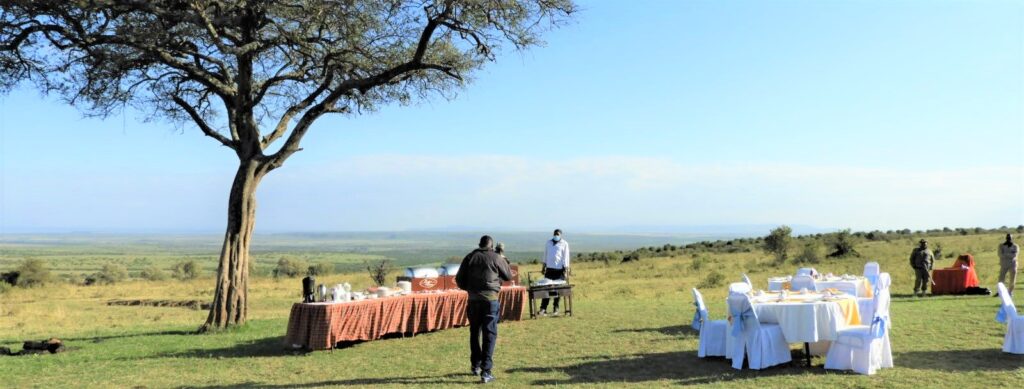
 It was a Sarova do, set up early and ready as our 4x4s came over the hill. They thought of everything – chafers of hot foods, grills to cook more, pastries and muffins and boxes for take-away, chilled drinks and hot, white-clothed tables, blue-bowed chairs, a tented potty and proper hand-washing station. Scenery clear to yonder and a blue-perfect sky. Who was there? I was, plus Rick, Otis, and Venita from Daniel’s 4×4; Mike, Lois, Ed, Maureen, and Judy from Frank’s 4×4. Guide Abdi, and all the Sarova staff who cooked and served and greeted and guarded. Yes, two guards with guns watching over us, precaution for our “out of vehicle” status. Isaac, left, is a Sarova employee-in-training who looked after me this morning; we talked about his work and family and life in Kenya, and my life in the USA; what a nice young man! The picture of us together turned out blurred, but the one of my “primary care-givers” on this safari is splendid – Abdi and Daniel and Frank with Rick and me, smiling, happy as kids at a birthday party. What a way to start a day!
It was a Sarova do, set up early and ready as our 4x4s came over the hill. They thought of everything – chafers of hot foods, grills to cook more, pastries and muffins and boxes for take-away, chilled drinks and hot, white-clothed tables, blue-bowed chairs, a tented potty and proper hand-washing station. Scenery clear to yonder and a blue-perfect sky. Who was there? I was, plus Rick, Otis, and Venita from Daniel’s 4×4; Mike, Lois, Ed, Maureen, and Judy from Frank’s 4×4. Guide Abdi, and all the Sarova staff who cooked and served and greeted and guarded. Yes, two guards with guns watching over us, precaution for our “out of vehicle” status. Isaac, left, is a Sarova employee-in-training who looked after me this morning; we talked about his work and family and life in Kenya, and my life in the USA; what a nice young man! The picture of us together turned out blurred, but the one of my “primary care-givers” on this safari is splendid – Abdi and Daniel and Frank with Rick and me, smiling, happy as kids at a birthday party. What a way to start a day!
We spotted two more Bush Breakfasts on our way to the plane. First time ever I was close enough to an elephant to observe exactly how one eats; I watched as she pulled grass from the ground and rolled it into her mouth, slow and easy, taking her time.
We stayed until the elephant families moved on. And then we passed a baboon family, breakfasting in their own front yard, right there in the beautiful Maasai Mara.
Sarova Mara Game Camp https://www.sarovahotels.com/maracamp-masai-mara/
» posted on Friday, September 16th, 2022 by Linda Lou Burton
Crossing The Mara
Linda Lou Burton posting from Sarova Mara Game Camp, Maasai Mara National Reserve, Kenya– The Great Migration, ah, that rousing event that sometimes results in more blood  and gore than even the Coen Brothers could think up. Or, it could wind up as cozy as a Sunday morning sleep-in, as we witnessed. We did see a crocodile-in-waiting, and a line of wildebeests stretching as far over the horizon as the eye can see. This photo I grabbed off the net shows what could, and often DOES, happen when a wildebeest tries to cross the Mara River, as below.
and gore than even the Coen Brothers could think up. Or, it could wind up as cozy as a Sunday morning sleep-in, as we witnessed. We did see a crocodile-in-waiting, and a line of wildebeests stretching as far over the horizon as the eye can see. This photo I grabbed off the net shows what could, and often DOES, happen when a wildebeest tries to cross the Mara River, as below.
 Why cross the Mara River? It begins with the weather. The weather creates rainy seasons and dry seasons. The rainy seasons are when the grasses grow. Over a million wildebeest eat a lot of grass. So do half a million zebras, and half a million eland and gazelles. When the grass is gone in one place, they move to a greener pasture. All this occurs in a regular pattern over a year’s time, as the grazers move in a clockwise direction from Tanzania’s Serengeti National Park across the border to the north to Kenya’s Maasai Mara and then back south again. As you can see on this map, they have to cross the Mara River twice to do that! And thousands of Nile crocodiles live in that river, just waiting for lunch to arrive. Which means people line up along the riverbanks to see what might happen. Will the wildebeests cross today while we’re here? What are they waiting for? Is there a leader, giving a signal? What causes the first one to start running, and what causes the others to follow in a spectacular frenzy of rolling and tumbling and jumping and swimming?
Why cross the Mara River? It begins with the weather. The weather creates rainy seasons and dry seasons. The rainy seasons are when the grasses grow. Over a million wildebeest eat a lot of grass. So do half a million zebras, and half a million eland and gazelles. When the grass is gone in one place, they move to a greener pasture. All this occurs in a regular pattern over a year’s time, as the grazers move in a clockwise direction from Tanzania’s Serengeti National Park across the border to the north to Kenya’s Maasai Mara and then back south again. As you can see on this map, they have to cross the Mara River twice to do that! And thousands of Nile crocodiles live in that river, just waiting for lunch to arrive. Which means people line up along the riverbanks to see what might happen. Will the wildebeests cross today while we’re here? What are they waiting for? Is there a leader, giving a signal? What causes the first one to start running, and what causes the others to follow in a spectacular frenzy of rolling and tumbling and jumping and swimming?
All a mystery, but Daniel did his part so we could see everything there was to see; shifting our 4×4 this way and that, around the 30 or so others waiting on our side of the river; all jockeying for position. And which WAS the best position? There were several possible crossing points. The other side of the river was lined with 4x4s too, and school buses, yes, this is a school-trip-worthy event. The zebras graze nervously as we wait; the giraffe stand high, peering, maybe counting the numbers of wildebeests in the line? Otis spotted a crocodile waiting on the riverbank. “It’s THERE!” he said, over and over, “by the zebra’s head!” My camera zoom finally caught it. Yep, zebra head by crocodile head. We waited. And we waited. And we waited. The hippos weren’t afraid, swimming the Mara with little hippo eyes just at the surface; stretching out on the bank in a muddle of hippo fat. And smiling, I swear!
We didn’t pack a lunch, so Abdi finally called TIME. He had an obligation to keep us fed, and it was a long drive back to Sarova’s dining room. “Sorry, we have to leave,” he said. Aww, shucks. Daniel made sure we had our own “crossing” thrill however, bless his heart. “Hold on!” he yelled, as he 4×4’ed us across a Mara mudhole. Then we passed a group of wildebeests that had already made it across, grazing in their greener pastures. A good morning, all told.
Note: During the migration about 250,000 wildebeest and 30,000 zebra die every year as a result of predation by carnivores, drowning, thirst, hunger, and exhaustion. An average of 6,250 animals drown or are trampled crossing the Mara River.
A Brighter Note: As many as 500,000 wildebeest are born between February and March each year as the rainy season begins. Approximately 8,000 young wildebeest are born every single day during the peak of the birthing season.



